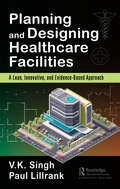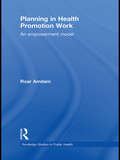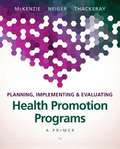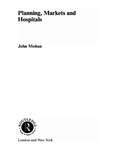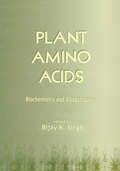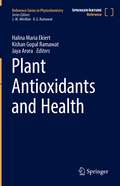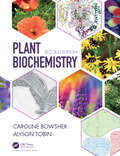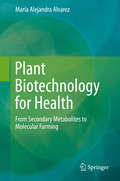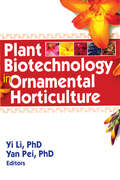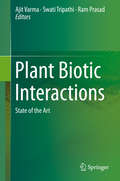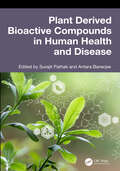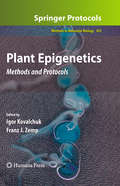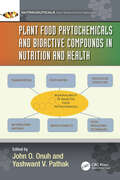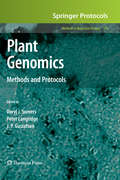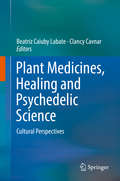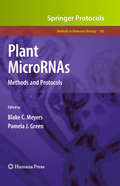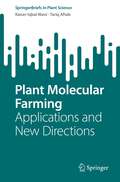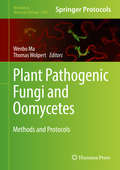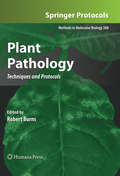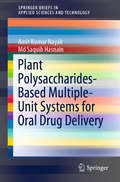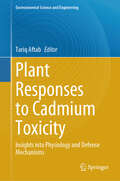- Table View
- List View
Planning and Designing Healthcare Facilities: A Lean, Innovative, and Evidence-Based Approach
by Paul Lillrank Vijai Kumar SinghThe planning and design of healthcare facilities has evolved over the previous decades from "function follows design" to "design follows function." Facilities stressed the functions of healthcare providers but patient experience was not fully considered. The design process has now crucially evolved, and currently, the impression a hospital conveys to its patients and community is the primary concern. The facilities must be welcoming, comfortable, and exude a commitment to patient well-being. Rapid changes and burgeoning technologies are now major considerations in facility design. Without flexibility, hospitals face quicker obsolescence if designs are not forward-thinking. Planning and Designing Healthcare Facilities: A Lean, Innovative, and Evidence-Based Approach explores recent developments in hospital design. Medical facilities have been adapted to the requirements of clinical functions. Recently, the needs of patients and clinical pathways have been recognized. With the patient at the center of the process, the flow of tasks becomes the guiding principle as hospital design must employ evidence-based thinking, and process management methods such as Lean become central. The authors explain new concepts to reduce healthcare delivery cost, but keep quality the primary consideration. Concepts such as sustainability (i.e., Green Hospitals) and the use of new tools and technologies, such as information and communication technology (ICT), Lean, and evidence-based planning and innovations are fully explained.
Planning and Making Crowns and Bridges
by Leslie C. Howe Bernard G.N. SmithThis highly successful text, which has achieved wide acclaim among practitioners and is a recommended text in the major dental schools, has again been revised and updated to keep it at the forefront of clinical practice.
Planning for Uncertainty: Living Wills and Other Advance Directives for You and Your Family (A Johns Hopkins Press Health Book)
by William Reichel David John DoukasIt won’t happen to me.I’m too busy to worry about a living will.My family will know what to do.No one wants to plan for death or incapacitating illness. But, as the emotional legal battle in the Terri Schiavo case made all too clear, people of all ages need to document and communicate clear decisions about the final details of their lives while they are healthy and have time to fully consider their own values and preferences.Here, Drs. David Doukas and William Reichel help individuals make decisions and communicate their wishes to health care providers and family members and other loved ones.Drs. Doukas and Reichel use a question-and-answer format to guide readers through the process—emphasizing the crucial connection between values and treatment preferences. They explain advance directives and the health care decision-making process, including the values history, family covenants, proxies, and proxy negation. The appendix includes resources and Web links for learning about advance directive requirements and obtaining legal forms in all fifty states.This practical guide helps people navigate the important but often intimidating process of thinking about, and planning for, an uncertain future.
Planning in Health Promotion Work: An Empowerment Model
by Roar AmdamCommunity development, planning and partnerships have become important terms in health promotion but, up until now, debate around these concepts have been discussed more in planning science than in public health literature. Roar Amdam draws on theories and new empirical evidence from local, regional and international planning and public health in order to develop a new model for health promotion: empowerment planning. Much health promotion planning has focused on top-down approaches, and while efforts to be participative are made, it is often without having a clear understanding of how community empowerment can be accommodated within health promotion programs. Amdam’s innovative concept combines top-down and bottom-up approaches to enable people to take more responsibility for their own health and for individual and collective capacity building. Planning in Health Promotion Work is suitable for all students and researchers of health promotion and health planning and development, whilst the numerous applied examples make it an invaluable resource for policymakers and practitioners working in public health.
Planning, Implementing, and Evaluating Health Promotion Programs: A Primer
by James McKenzie Rosemary Thackeray Brad NeigerIt provides students with a comprehensive overview of the practical and theoretical skills needed to plan, implement, and evaluate health promotion programs in a variety of settings. The features updated information throughout, including the new Responsibilities and Competencies generated from the Health Education Specialist Practice Analysis–2015 (HESPA-2015), and reflects the latest trends in the field.
Planning, Markets and Hospitals
by John MohanImproving access to hospital services has been a goal of public policy in Britain for over seventy years, but the means by which this goal is to be attained have changed significantly over time. Drawing substantially on original research, lanning, Markets and Hospitals represents a systematic attempt to access the strengths and weaknesses of different forms of planning and coordination of hospital development.The period covered includes: services prior to 1948; wartime hospital policy; the successes and failures of the mixed economy of health care in the inter-war period; the national hospital plan of 1962 and ultimately the market based reforms of 1991 and the changes since.This book makes a fresh contribution to enduring debates about planning and regulation of health care, about the governance of welfare services and about the appropriate role for voluntary, commercial and charitable provision of services. It reinterprets previous histories of hospital policy and questions whether current policies will reconcile competing goals of equity and choice.
Plant Amino Acids: Biochemistry and Biotechnology (Books in Soils, Plants, and the Environment)
by Bijay K. SinghCovers the basic knowledge of the regulation of biosynthesis of various amino acids in plants and the application of this knowledge to the discovery of novel inhibitors of amino acid biosynthesis and for enhancing the nutritional value of plant products. Provides an exhaustive list of pathway inhibitors.
Plant Antioxidants and Health (Reference Series in Phytochemistry)
by Kishan Gopal Ramawat Halina Maria Ekiert Jaya AroraThis book provides a comprehensive reference guide to plant-derived antioxidants, their beneficial effects, mechanisms of action, and role in disease prevention and improving general health (anti-ageing effect). The content is divided into three main parts, the first of which covers various antioxidants (such as polyphenols, carotenoids, tocopherols, tocotrienols, glutathione, ascorbic acid), their origins, plant biochemistry and industrial utilization. In turn, the book’s second, main part focuses on antioxidants’ beneficial health effects, explains biochemical fundamentals such as the free radical theory and oxidative stress, and discusses antioxidants’ role in e.g. cancer, cardiovascular diseases, inflammation, degenerative diseases and ageing. The third part reviews general laboratory methods for antioxidant screening, preservation and determination. Written by an international team of experts, this highly interdisciplinary book will benefit a broad range of health professionals and researchers working in biochemistry, biotechnology, nutrition, plant science and food chemistry. It offers an indispensable, up-to-date guide for anyone interested in antioxidants and the role of a plant-based diet in disease prevention and control
Plant Biochemistry
by Caroline Bowsher Alyson TobinPlant Biochemistry focuses on the molecular and cellular aspects of each major metabolic pathway and sets these within the context of the whole plant. Using examples from biomedical, environmental, industrial and agricultural applications, it shows how a fundamental understanding of plant biochemistry can be used to address real-world issues. It illustrates how plants impact human activity and success, in terms of their importance as a food supply and as raw materials for industrial and pharmaceutical products, and considers how humans can benefit from exploiting plant biochemical pathways. All chapters in this second edition have been substantially revised to incorporate the latest research developments, and case studies include updates on progress in developing novel plants and plant products. The artwork, now in full color, superbly illustrates the key concepts and mechanisms presented throughout. Key features: Presents each topic from the cellular level to the ecological and environmental levels, placing it in the context of the whole plant. Biochemical pathways are represented as route maps, showing how one reaction interacts with another both within and across pathways. Includes comprehensive reading lists with descriptive notes to enable students to conduct their own research into topics they wish to explore further The wide-ranging approach of this book emphasizes the importance of teaching and learning plant biochemical pathways within the framework of what the pathway does and why it is needed. Illustrates the fundamental significance of plants, in terms of their importance as a food supply, as raw materials and as sources of novel products. Plant Biochemistry is invaluable to undergraduate students who wish to gain insight into the relevance of plant metabolism in relation to current research questions and world challenges. It should also prove to be a suitable reference text for graduates and researchers who are new to the topic or who wish to broaden their understanding of the range of biochemical pathways in plants.
Plant Biotechnology and Medicinal Plants: Periwinkle, Milk Thistle and Foxglove
by Mohamed Ramadan RadyPlant tissue culture and advanced biotechnologies have proven to be influential tools that complement conventional breeding and accelerate development of many medicinal plants. Various approaches, such as pathway engineering, precursor feeding, transformation, elicitation with biotic and abiotic elicitors and scaling up in bioreactors, have been explored to improve the production of secondary metabolites from different medicinal plants. This book provides a comprehensive description of various studies, carried out on in vitro culture and hairy root cultures of Catharanthus roseus, Silybum marianum and Digitalis species which have been considered as alternative sources for the production of anti-tumour compounds, flavonolignans and cardenolides. Specific focus is on elicitation strategy for increasing production of bioactive compounds of C. roseus L., S. marianum and Digitalis species to overcome the constrains of conventional propagation. This book is valuable for researchers or students working on medicinal plants, phytochemistry, and plant tissue culture. It also serves as a reference for the pharmaceutical industry.
Plant Biotechnology for Health
by María Alejandra AlvarezIn this book emphasis will be put in the relevance of Plant Biotechnology for producing compounds of pharmaceutical and industrial relevance specifically the contribution of in vitro plant cell cultures for producing recombinant proteins (molecular farming) and compounds produced by plants useful for human and animal health (secondary metabolites) will be discussed. Also the description of some process held by whole plants will be included. The aim will be to provide relevant theoretical frameworks and the latest empirical research findings for professionals and researchers working in the field of Plant Biotechnology, molecular farming and biochemical engineering.
Plant Biotechnology in Ornamental Horticulture
by Yi Li Yan PeiFind out how biotechnology can produce more nutritious fruits and vegetables, more colorful flowers, and grass that needs less waterand mowing!Plant Biotechnology in Ornamental Horticulture presents an in-depth overview of the key scientific and technical advances, issues, and challenges in one of the fastest growing segments of
Plant Biotic Interactions: State of the Art
by Ajit Varma Ram Prasad Swati TripathiThis book highlights recent advances in the field of plant-biotic interactions and explores current serious issues in the crop production industry. It is intended to attract more attention to these important, but often overlooked areas, and to stimulate new ideas for future research. Plants are constantly under attack by pathogens, pests, and parasites, which can significantly impact worldwide food production and human health. While pathogens and pests attack and interconnect with their hosts in a variety of ways, plants have developed sophisticated immune systems to fight infections. In the field of plant-biotic interactions, most of the studies to date have focused on the function and signaling pathways of plant disease resistance proteins and pattern recognition receptors, as well as pathogen effector proteins. In contrast, this book presents new and emerging research areas, and introduces students, researchers, academics, and policy advisors to the latest trends in e.g. microbial technology, environmental microbiology, agricultural science, the health sciences, biological sciences and other related disciplines.
Plant Chemical Genomics
by Glenn R Hicks Stéphanie RobertPlant Chemical Genomics: Methods and Protocols , expert researchers in the field detail many of the techniques used for identification of bioactive compounds from a large selection of fields in plant biology including plant pathogenesis, immune responses, small RNA processing, endomembrane trafficking, lipids, plant hormone signaling and cell wall. The presentation of these and other examples as well as synthetic chemistry, computation and target identification provides a comprehensive overview of the practical aspects of chemical biology that are possible in plant systems. Small molecules and natural products that produce a phenotype in plants have been known for decades. The agrichemical industry has utilized small molecules based on known natural molecules such as auxins, cytokinins, abscissic acid and other growth regulators. In recent years, the screening and characterization of novel small molecules has enhanced our understanding of protein function, metabolic, signaling and endomembrane pathways, and their interactions in basic plant research. Written in the highly successful Methods in Molecular Biology series format, chapters include introductions to their respective topics, lists of the necessary materials and reagents, step-by-step, readily reproducible laboratory protocols, and key tips on troubleshooting and avoiding known pitfalls.
Plant Derived Bioactive Compounds in Human Health and Disease
by Surajit Pathak Antara BanerjeeThis book offers a comprehensive review of the multifaceted role of phytochemicals in promoting human health and combating diseases. The initial chapters introduce phytochemicals, navigate the natural health landscape, and provide a foundational understanding of these bioactive compounds. The book unfolds the role of phytochemicals as a formidable defense against oxidative stress and explores the unique health benefits and nutritional significance of phytochemicals found in fruit peels. The subsequent chapters further discuss the therapeutic potential of phytochemicals, detailing their role in combating multidrug-resistant bacterial infections and modulating critical pathways in inflammation and cancer. This book also highlights the novel treatment strategies for amyloidosis using natural products, as well as the fascinating interplay between natural compounds and biogenic nanoparticles in the context of polycystic ovarian syndrome (PCOS). Further exploration includes the impact of plant-derived compounds on cancer stem cells and the recent advancements in ethnopharmacology for age-related brain disorders. Each chapter provides a thorough and up-to-date analysis of research findings, clinical applications, and future directions within the field. By presenting a holistic view of the diverse functions and benefits of phytochemicals, this book aims to inspire further investigation and innovation in this dynamic area of research, ultimately contributing to enhanced human health and well-being.
Plant Epigenetics
by Igor Kovalchuk Franz J. ZempThe past fifteen years have witnessed major advances in epigenetics, one of the most popular and quickly evolving fields of modern science. In Plant Epigenetics: Methods and Protocols, expert researchers explore the most recent developments, examining in great detail the contribution of epigenetic regulation to cell function in plants. Chapters include a variety of protocols for studying the function of small non-coding RNAs, DNA methylation, and histone modifications in plants, often in different degrees of complexity. This volume describes bioinformatic approaches to the analysis of high-throughput data, such as bisulfite sequencing and Chip-on-chip assays. It features much-desired protocols for plant transgenesis and the analysis of genome stability, with a detailed discussion of their applications to epigenetic studies. Composed in the highly successful Methods in Molecular BiologyTM series format, each chapter contains a brief introduction, step-by-step methods, a list of necessary materials, and a Notes section which shares tips on troubleshooting and avoiding known pitfalls. Wide-ranging and innovative, Plant Epigenetics: Methods and Protocols is an invaluable manual designed to help researchers uncover the undiscovered and unexplained phenomena in plant biology.
Plant Food Phytochemicals and Bioactive Compounds in Nutrition and Health (Nutraceuticals)
by Yashwant V Pathak John O OnuhPhytochemicals are receiving increasing attention due to their observed nutritional and health-promoting effects in numerous food applications. As plant secondary metabolites with bioactive properties, they may provide desirable health benefits beyond basic nutrition to reduce chronic disease conditions. Their importance in nutrition and health cannot be overstated as it has generated so much interest and studies focused on elucidating their roles has produced so many outstanding results. Plant phytochemicals are readily used in alternative medicine in South East Asia especially, in China and India and they are becoming widely acceptable worldwide. However, very little is still known about the phytochemicals despite these intense research efforts because of their diverse biological and chemical nature.In this newest addition to the series, Nutraceuticals: Basic Research and Clinical Applications, Plant Food Phytochemicals and Bioactive Compounds in Nutrition and Health provides a comprehensive review of the current state of knowledge in the field of bioactive plant phytochemical compounds, their food sources, bioactivities, bioavailability, extraction, production, and applications. Experts in the field discuss various bioactivities of the notable and promising plant phytochemicals of significance in nutrition and health, e.g., lowering of CVD, hypertension, cholesterol, diabetes, obesity, inflammation, cancer, oxidative stress, neurodegenerative diseases and a host of other chronic disease conditions.Key Features: Describes the various nutritional and bioactive significances of notable and promising plant phytochemicals of significance in nutritional and medical research and their food and/or plant sources Includes various approaches for the quantification, extraction and production of the notable and promising phytochemical compounds in nutrition and health Examines the challenges and promises of plant phytochemical as ingredients for the development of functional foods and nutraceuticals as well as their use in alternative medicine Discusses regulatory issues regarding plant phytochemicals, especially as it pertains to their health claims and use
Plant Genomics
by J. P. Gustafson Peter Langridge Daryl J. SomersPlant genomics is a growing and constantly evolving field of study, one which has gained much ground in past years through the development of advanced research and data management tools. In Plant Genomics: Methods and Protocols, expert researchers explore the current issues and methodologies of this expanding field, specifically addressing areas of gene discovery and the functional analysis of genes with a focus on the primary tools and sub-disciplines of genetic mapping, mRNA, protein and metabolite profiling. Chapters employ exciting new methods to investigate molecular plant breeding technology and gene functional analysis via transformation, mutation, protein function, and gene expression. Composed in the highly successful Methods in Molecular Biology series format, each chapter contains a brief introduction, step-by-step methods, a list of necessary materials, and a Notes section which shares tips on troubleshooting and avoiding known pitfalls. Comprehensive and innovative, Plant Genomics: Methods and Protocols is an essential guide for all plant scientists who are interested in further studies in the area of genomics research.
Plant Medicines, Healing and Psychedelic Science: Cultural Perspectives
by Beatriz Caiuby Labate Clancy CavnarThis is a book about the intersections of three dimensions. The first is the way social scientists and historians treat the history of psychiatry and healing, especially as it intersects with psychedelics. The second encompasses a reflection on the substances themselves and their effects on bodies. The third addresses traditional healing, as it circles back to our understanding of drugs and psychiatry. The chapters explore how these dimensions are distinct, but deeply intertwined, themes that offer important insights into contemporary healing practices.The intended audience of the volume is large and diverse: neuroscientists, biologists, medical doctors, psychiatrists, psychologists; mental health professionals interested in the therapeutic application of psychedelic substances, or who work with substance abuse, depression, anxiety, and PTSD; patients and practitioners of complementary and alternative medicine; ethnobotanists and ethnopharmacologists; lawyers, criminologists, and other specialists in international law working on matters related to drug policy and human rights, as well as scholars of religious studies, anthropologists, sociologists, and historians; social scientists concerned both with the history of science, medicine, and technology, and concepts of health, illness, and healing. It has a potentially large international audience, especially considering the increasing interest in “psychedelic science” and the growing spread of the use of traditional psychoactives in the West.
Plant MicroRNAs
by Pamela J. Green Blake C. MeyersMicroRNAs constitute a particularly important class of small RNAs given their abundance, broad phylogenetic conservation and strong regulatory effects, with plant miRNAs uniquely divulging their ancient evolutionary origins and their strong post-transcriptional regulatory effects. In Plant MicroRNAs: Methods and Protocols, experts in the field present chapters that focus on the identification, validation, and characterization of the miRNA class of RNAs, and address important aspects about heterochromatic small interfering RNAs. In addition, the methods contained in this volume emphasize miRNA analyses, but also include ways to distinguish one class of small RNAs from another. As a volume in the highly successful Methods in Molecular BiologyTM series, chapters include brief introductions to their respective topics, lists of the necessary materials and reagents, step-by-step, readily reproducible laboratory protocols, and notes on troubleshooting and avoiding known pitfalls. Authoritative and easy to use, Plant MicroRNAs: Methods and Protocols provides the research community with a set of protocols that will help advance vital miRNA research for all plant species, both in typical model species and non-model species alike.
Plant Molecular Farming: Applications and New Directions (SpringerBriefs in Plant Science)
by Tariq Aftab Kaiser Iqbal WaniMolecular farming is a biotechnological approach that includes the genetic adjustment of agricultural products to create proteins and chemicals for profitable and pharmaceutical purposes. Plant molecular farming describes the manufacture of recombinant proteins and other biologically active product in plants. This approach depends on a genetic transformation of plants that can be accomplished by the methods of stable gene transfer, such as gene transfer to nuclei and chloroplasts, and unstable transfer methods like viral vectors. The requirement for recombinant proteins in terms of quality, quantity, and diversity is increasing exponentially This demand is traditionally met by recombinant protein construction technologies and the engineering of orthodox expression systems based on bacteria or mammalian cell cultures. However, majority of developing countries cannot afford the high costs of medicine derived from such existing methods. Hence, we need to produce not only the new drugs but also the cheaper versions of those already present in the market. Plant molecular farming is considered as a cost-effective technology that has grown and advanced tremendously over the past two decades. This book summarizes the advances and challenges of plant molecular farming for all those who are working on or have an interest in this rapidly emerging area of research.
Plant Pathogenic Fungi and Oomycetes: Methods And Protocols (Methods in Molecular Biology #1848)
by Wenbo Ma Thomas WolpertThis book describes approaches for the analysis of plant pathogenic fungi that range from ecosystem composition to in vitro and wet-lab to computational analyses. Chapters detail bioinformatics protocols for genome assembly, transcriptome analysis and small RNA profiling, characterization of secondary metabolome, analysis of post-translational modification and localization of proteins, examination of virulence function and interaction with plants or other microorganisms, and targeted mutagenesis using various approaches. Written in the highly successful Methods in Molecular Biology series format, chapters include introductions to their respective topics, lists of the necessary materials and reagents, step-by-step, readily reproducible laboratory protocols, and tips on troubleshooting and avoiding known pitfalls. Authoritative and cutting-edge, Plant Pathogenic Fungi and Oomycetes: Methods and Protocols aims to provide techniques developed through a wide range of perspectives to facilitate research on a comprehensive understanding of these important filamentous pathogens.
Plant Pathology
by Robert BurnsPlant diseases can have an enormous impact on our lives. In a world where total crop failure can quickly lead to human misery and starvation, accurate diagnostics play a key role in keeping plants free from pathogens. In Plant Pathology: Techniques and Protocols, expert researchers provide methods which are vital to the diagnosis of plant diseases across the globe, addressing all three categories of plant pathology techniques: traditional, serological, and nucleic acid. Chapters examine recent and developing issues with crop identity and authenticity, allowing workers to genotype samples from two major food groups. Composed in the highly successful Methods in Molecular BiologyTM series format, each chapter contains a brief introduction, step-by-step methods, a list of necessary materials, and a Notes section which shares tips on troubleshooting and avoiding known pitfalls. Authoritative and reader-friendly, Plant Pathology: Techniques and Protocols is an incredible guide which will soon prove to be indispensable, both to novices and expert researchers alike.
Plant Polysaccharides-Based Multiple-Unit Systems for Oral Drug Delivery (SpringerBriefs in Applied Sciences and Technology)
by Amit Kumar Nayak Md Saquib HasnainThis book explores the use of various plant polysaccharides for pharmaceutical purposes, including drug delivery. It examines the exploitation of plant polysaccharides’ auxiliary functions to enhance drug release, stability, bioavailability and target specificity. Plant-derived materials are at the center of drug-delivery research thanks to their non-toxicity, biodegradability, ready availability, eco-friendliness and low extraction costs. These materials include polysaccharides, a class of naturally occurring polymers consisting of glucose monomers, which serve as storage carbohydrates in cereals, root vegetables, rhizomes, seeds, fruits, etc.
Plant Responses to Cadmium Toxicity: Insights into Physiology and Defense Mechanisms (Environmental Science and Engineering)
by Tariq AftabThis book offers an exploration of how plants respond to the presence of cadmium, shedding light on both the physiological and molecular mechanisms In an era of growing environmental concern, this edited book serves as an invaluable resource, shedding light on the intricate interplay between plants and cadmium, a menacing environmental pollutant. Cadmium's pervasive presence in the soil poses a significant threat to plant ecosystems, impacting food security and human well-being. This comprehensive book explores the multifaceted responses of plants to cadmium toxicity, offering critical insights into the physiological and molecular mechanisms governing these reactions. The edited book delves into the intricate relationship between plants and cadmium, a highly toxic heavy metal. Cadmium contamination in the environment, largely stemming from industrial processes and agricultural practices, poses a significant threat to plant ecosystems and, by extension, human and environmental health. This book offers a comprehensive exploration of how plants respond to the presence of cadmium, shedding light on both the physiological and molecular mechanisms that govern these responses. Written by leading experts in the field, this book provides a holistic understanding of the challenges posed by cadmium contamination and the innovative strategies plants employ to combat its detrimental effects. It encompasses a wide array of topics, from the physiological changes plants undergo under cadmium stress to the genetic and molecular pathways activated in response. Furthermore, it explores the practical potential of phytoremediation, a sustainable approach that harnesses plants' abilities to detoxify contaminated environments. This book is a valuable resource for researchers, scholars, and students in the fields of plant biology, environmental science, and toxicology, offering a deep understanding of the challenges presented by cadmiumcontamination and the innovative strategies that plants employ to adapt and thrive in the face of adversity. With a focus on both fundamental science and practical applications, this edited book offers a comprehensive perspective on a critical issue in modern agriculture, environmental science, and plant biology.
